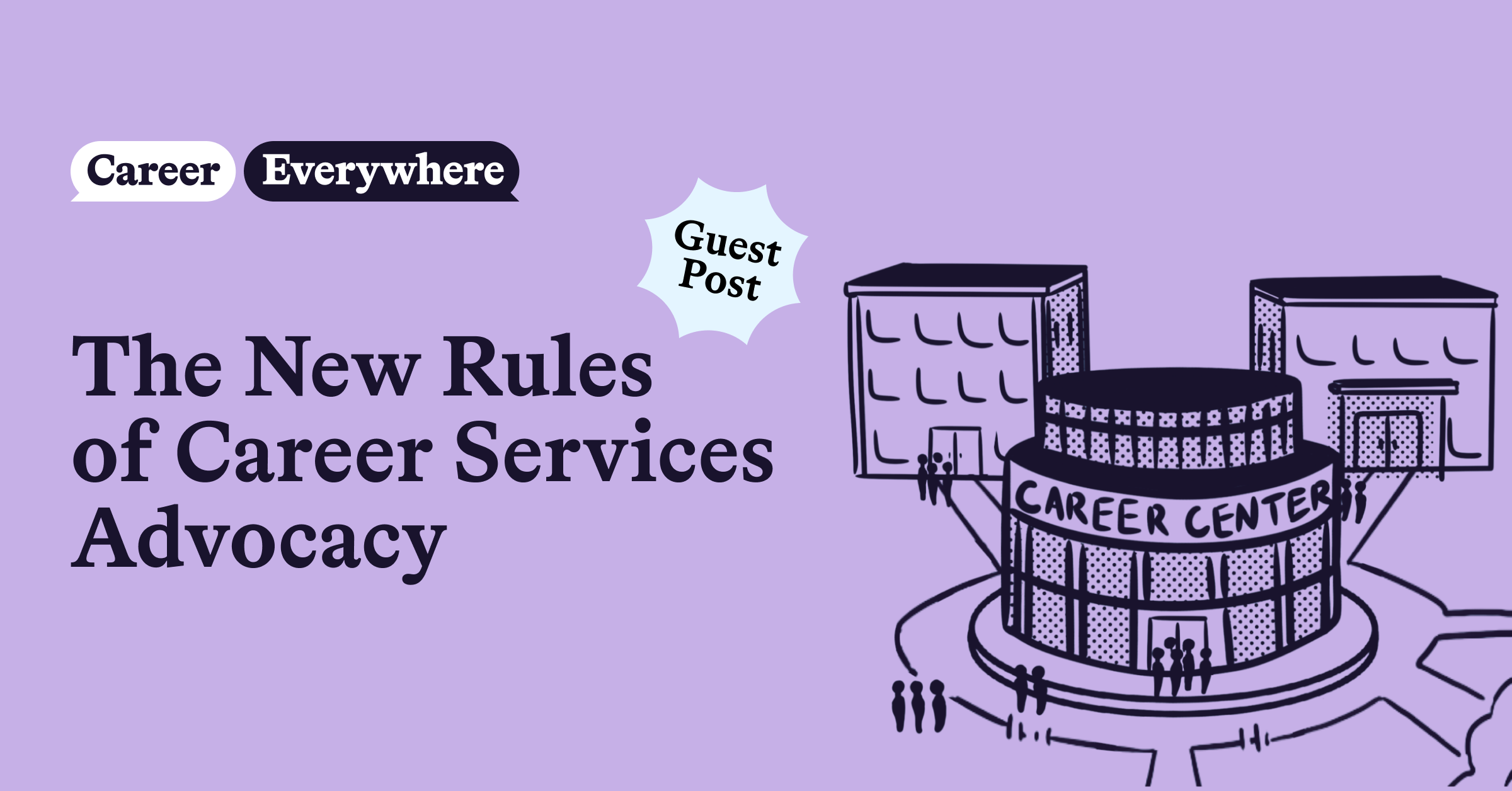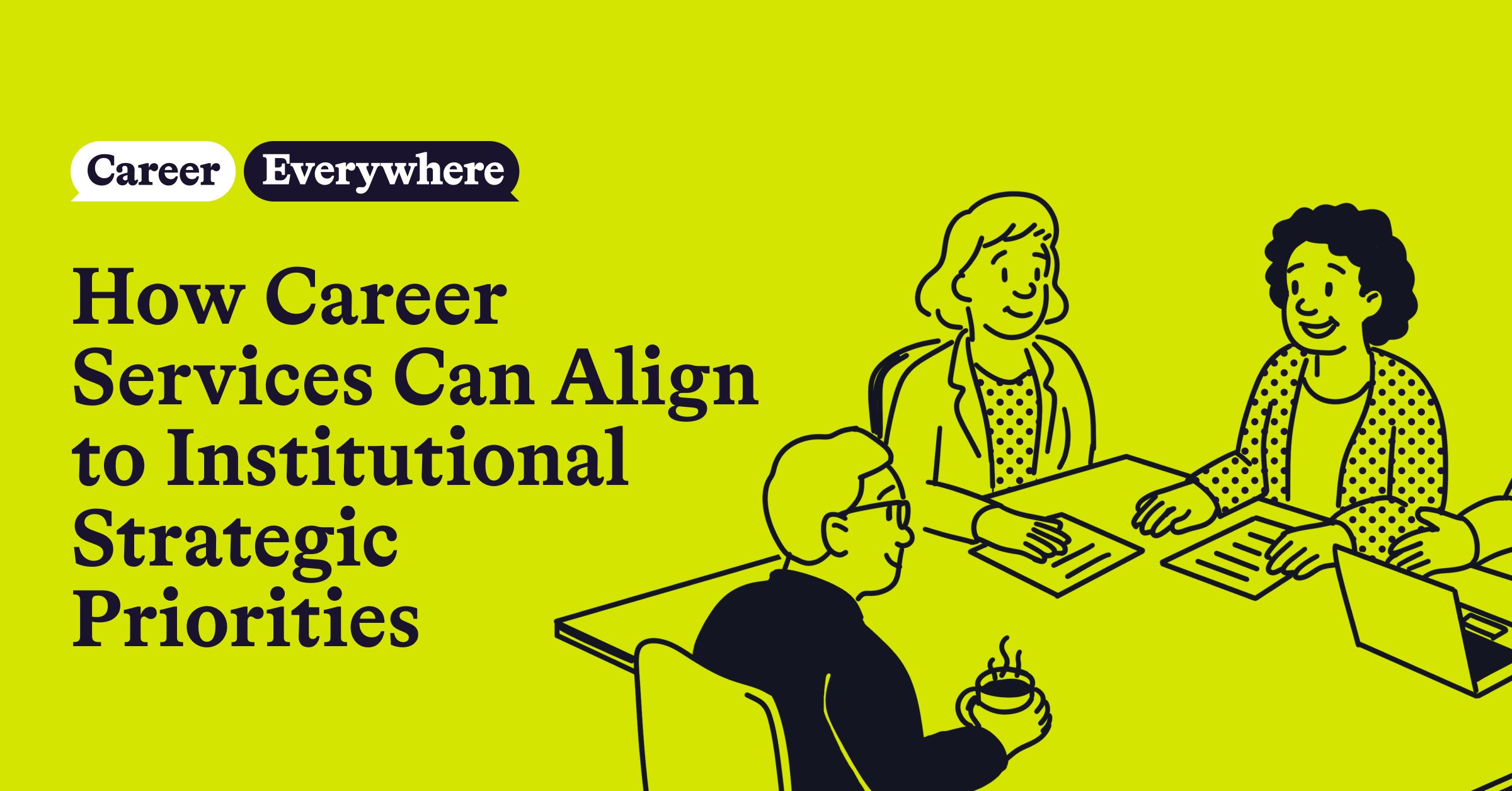
Presidents are losing sleep over looming federal research cuts.
Trustees are worried about endowment taxes and donor fatigue.
Admissions is bracing for the enrollment cliff.
And yet—
Amid all the noise, one of higher ed’s biggest opportunities is flying under the radar:
Career services.
At a time when accountability for student outcomes is intensifying—from Washington to state capitols to prospective families—career services should be at the center of strategy conversations.
But they’re not.
Because too often, the people at the top simply don’t know what career services can do.
That’s not a judgment. It’s a call to action.
The accountability era is here—and career services is the missing link
Federal pressure is mounting.
Policymakers and watchdogs are asking tough questions about:
- Graduate salaries and loan repayment
- ROI by major and institution
- Skills gaps and workforce alignment
- Career preparation across the student lifecycle
- Accreditation tied to post-college outcomes
Many states are echoing the same priorities.
Governors are looking to public institutions to help strengthen the in-state talent pipeline—not just by preparing graduates for the workforce, but by encouraging them to stay. Some are even experimenting with financial incentives to retain graduates locally (e.g., Maine, New York, Vermont, among others).
In Virginia, for example, legislation now requires every student to participate in a work-based learning experience before graduation—signaling just how central career preparation has become to the public value proposition of higher education (even if they can’t hold institutions accountable yet).
Other states are making bold moves:
- Colorado passed legislation requiring public colleges to report post-graduation outcomes like earnings, job placement, and debt repayment. A statewide dashboard is being built to give prospective students access to this data before they enroll.
- Indiana and Utah are tying funding to academic “productivity,” directing institutions to eliminate low-wage or low-enrollment programs.
- Florida is expanding its “money-back guarantee” for workforce-aligned programs—promising either a job or a tuition refund.
- Ohio is pushing universities to become more “efficient,” eliminating certain programs while emphasizing employment outcomes.
And across the country, governors are embedding career-connected learning into K–12 policy, with states like Indiana, Maryland, Iowa, and California launching new career development initiatives well before students reach college.
The message is clear: Career preparation is no longer optional.
This isn’t just a policy trend—it’s a system-wide recalibration.
From Carnegie’s new classifications focused on economic mobility, to state mandates tying funding to workforce alignment, to federal proposals reframing accreditation, one thing is clear:
The value of higher education is being redefined.
And career services—though rarely named outright—is central to the outcomes policymakers care about most: access, ROI, equity, and employment.
Ironically, while many campus leaders are working overtime to protect their institution’s reputation and revenue, few are investing in one of the best solutions they already have: A modern, mission-aligned, equity-driven career services strategy.
Why advocacy starts with education
Let’s be clear: Most presidents, provosts, and trustees aren’t hostile to career services.
They’re just… distracted.
Busy.
Unaware of what today’s career centers can and should be doing.
They don’t know:
- That career engagement boosts retention and belonging
- That career data can strengthen admissions and advancement messaging
- That a coordinated strategy can meet workforce demands and differentiate their institution
So when you advocate for career services, don’t just ask for resources.
Educate.
Frame your message in the language of institutional priorities:
- Enrollment
- Student success
- Donor relations
- Regional impact
- Risk mitigation
- Reputation
And then show them how career services delivers.
Go beyond outcomes—highlight what makes you different
Yes, you need to share career outcomes.
But here’s the truth: Everyone is doing it now.
(And some are stretching the truth in ways that raise eyebrows.)
So how do you stand out?
You show how those outcomes were achieved—and for whom:
- Embedded career development in orientation, classrooms, advising, and student employment
- Intentional equity strategies for first-gen and underserved students
- Faculty partnerships that turn reflection and relevance into routine
- Employer collaborations that go beyond job postings
- Backwards design that scaffolds career readiness from day one
- Alignment with state workforce priorities—including efforts to strengthen regional pipelines and retain graduates in-state
- Use a platform like uConnect to move beyond static metrics: uConnect’s Virtual Career Center enables you to surface detailed analytics to prove ROI and show where and how your students are engaging.
When you combine real results with a replicable, inclusive model—that’s when leadership starts paying attention.
How to get in the room—even if you’re not at the table
Career services is often buried two, three, or even four layers down in the organizational chart.
So what do you do when your work is affected by decisions made in rooms you’re not invited to?
You find other ways to get in.
You don’t need a seat at the board table to shape the conversation.
You need strategy, timing, and translation.
Here’s how to make sure your work reaches the people making the big decisions:
1. Know the rhythm of executive meetings
These events are predictable—and staff often begin preparing for them months in advance.
- Find out when trustee meetings, cabinet briefings, and strategic planning sessions happen throughout the year.
- Mark those dates now.
- Then work backward to time your contributions and prepare supporting materials before the agenda is set.
2. Equip your supervisor (or their supervisor)
- Create clear, compelling talking points and short briefing documents they can use in high-level meetings.
- Include key metrics, student stories, employer wins, and aligned recommendations.
- Bonus: Tie your message to their priorities (e.g., enrollment, fundraising, retention, public image).
3. Offer to ghostwrite or contribute to leadership updates
Many deans, VPs, or provosts write monthly or quarterly updates for campus leaders.
- Offer a short list of data-informed bullets highlighting career services success—and show how it supports broader institutional goals.
- Provide talking points before key meetings.
4. Build partnerships with power-adjacent units
Advancement, enrollment, and institutional research often have more direct lines to cabinet or trustees.
- Collaborate on shared data or stories they can bring forward.
- Ask how your work could help them shine—and then follow up with usable content.
5. Create urgency without alarmism
Don’t wait for a budget cut or board directive. Instead, frame risks and opportunities as windows for action.
- For example: “We’re seeing declining employer interest in X majors. If we address this now through new partnerships—and make them visible through our uConnect platform—we can stay ahead of the curve.”
6. Develop a presidential dashboard
- Design a one-pager or short slide deck with 3–5 metrics that matter to senior leadership—like engagement by equity group, outcomes by program, or employer activity trends. Show movement.
- Update it quarterly and circulate it through your VP.
7. Use student and employer voices
- Sometimes quotes are more powerful than stats.
- Capture short student testimonials or recruiter feedback and package it as a “pulse check” from the field.
8. Ask for five minutes at a leadership team meeting
- Even if it’s just with your division head’s cabinet, use that time to position career services as a strategic partner.
- Speak at a high level, and bring solutions, not just updates.
9. Anticipate the questions leadership will be asked
What’s our ROI on student services? How are we meeting workforce goals? Who’s partnering with employers?
- Be the person who already has those answers ready.
You don’t need a title change to have influence—but you do need to speak the language of leadership. That means surfacing insights, not just activities. Framing risks, not just problems. And offering strategic solutions—not the sausage-making that got you there or that’s hanging you up.
When you elevate your message, you elevate your office. And that’s how you begin to shape the narrative—long before you’re officially in the room.
Because at the end of the day, great advocacy is just great education. Let’s talk about how to lead with it.
Be the educator, not just the advocate
We’re entering a new era—one where career outcomes are not an afterthought, but a core metric of higher education’s value.
The risk? If we don’t step forward, others will design systems without us.
The opportunity? You’ve already been doing this work.
Now’s the time to make it visible—by translating it into the language your leadership understands and showing how your office is a strategic driver of institutional success.
Career services professionals are educators. You don’t have to sell or beg.
You have to teach—strategically, consistently, and confidently.
Tools like uConnect help career teams become more visible, strategic, and scalable—elevating your work beyond your office walls and into the institutional narrative.
Presidents and trustees want results.
They want differentiation.
They want a story they can tell donors, legislators, and accreditors.
Career services can give them all of that.
But first, they need to see it.


